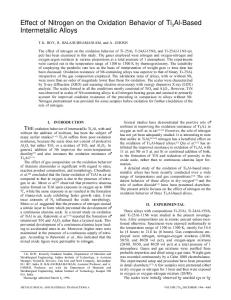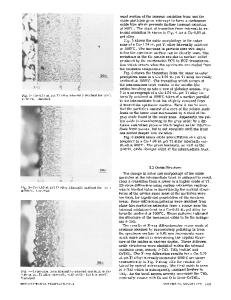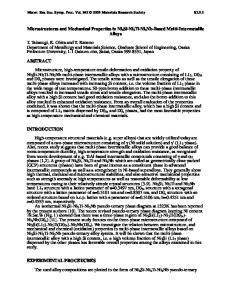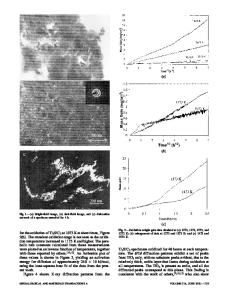Oxidation and Protection of Ti 3 Al-Based Intermetallic Alloys
- PDF / 967,859 Bytes
- 6 Pages / 420.48 x 639 pts Page_size
- 80 Downloads / 369 Views
OXIDATION AND PROTECTION OF Ti3AL-BASED INTERMETALLIC ALLOYS DOUGLAS W. McKEE General Electric Corporate Research and Development, P.O. Box 8, Schenectady, New York 12301. ABSTRACT Titanium aluminides containing 20-30 atom percent Al can suffer from severe subsurface embrittlement (alpha-case) when exposed to air at elevated temperatures for extended periods. For example,the alloys Ti-24AI-12.5Nb-l.5Mo and Ti-24AI-8Nb-2Mo-2Ta (based on the Ti3AI alpha-2 intermetallic compound) embrittle to a depth of about 80 microns during 1000 hours exposure to air at 815°C (1500°F), resulting in major reductions in tensile properties. Plasma-sprayed coatings of the MCrAlY and MCr types deposited over a thin diffusion barrier of chromium or tungsten, have been found effective in protecting these alloys against oxidation and embrittlement at this temperatures. INTRODUCTION Alloys based on the alpha-2 intermetallic compound Ti3AI are of increasing interest for aircraft and aerospace applications because of their low density and strength at elevated temperatures [1]. Although the binary alloy is brittle, improved ductility can be achieved by adding small amounts of other elements, such as niobium, tantalum or molybdenum [21. These materials are also being investigated as possible matrices for fiber-reinforced metal matrix composites [3]. However, titanium alloys in general are susceptible to oxidation in air above 600"C and the alpha-2 family of alloys are particularly vulnerable to sub-surface embrittlement ("alpha-case") during elevated temperature exposure as a result of dissolution of oxygen in the metal lattice [4]. This hardening effect can cause serious degradation of mechanical properties [5]. It is likely, therefore, that protective coatings will be required for applications of alpha-2 alloys that involve exposure to air at temperatures exceeding 600°C. In an earlier study [6], plasma-spray coatings of the MCrA1Y- and MCr- types were found effective in protecting (alpha+beta) titanium aluminide alloys against oxidation in air for long periods of time at temperatures as high as 850*C. This paper summarizes the results of an investigation of the behavior of these coatings on two typical alpha-2 type alloys. Experimental The alpha-2 alloys used as substrates for the coating studies had the nominal compositions (atom percent): Ti-24AI-12.5Nb-1.5Mo and Ti-24AI-8Nb-2Mo-2Ta. Cast-and-forged ingots of these alloys were prepared and given appropriate heat and annealing treatments. Pins 1.25 in. long and 0.125 in. diameter were cut from these ingots by electrical discharge machining. The pins were centerless ground, the ends rounded and the surfaces given a buffing treatment before the coating procedure. Previous work [7] had shown that the diffusion of coating elements into the alloy substrates during high temperature exposure could be minimized by interposing a thin barrier layer of tungsten or chromium between the coating and the substrate. This layer (1-2 microns thick) was applied to the pins by RF sputtering before the low pres
Data Loading...











